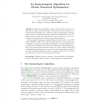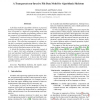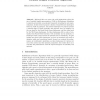1578 search results - page 124 / 316 » Algorithmic randomness of continuous functions |
WSC
2007
15 years 6 days ago
2007
In this paper we introduce the completed unit algorithm (CU-AL), a probabilistic scheduling methodology for repetitive projects. The algorithm has two main advantages, simplicity ...
AE
2005
Springer
15 years 3 months ago
2005
Springer
Abstract. Numerical optimization of given objective functions is a crucial task in many real-life problems. The present article introduces an immunological algorithm for continuous...
IPPS
2008
IEEE
15 years 4 months ago
2008
IEEE
A file data model for algorithmic skeletons is proposed, focusing on transparency and efficiency. Algorithmic skeletons correspond to a high-level programming model that takes a...
GECCO
2007
Springer
15 years 4 months ago
2007
Springer
A survey of niching algorithms, based on 5 variants of derandomized Evolution Strategies (ES), is introduced. This set of niching algorithms, ranging from the very first derandom...
AE
2003
Springer
15 years 3 months ago
2003
Springer
Although there are some real world applications where the use of variable length representation (VLR) in Evolutionary Algorithm is natural and suitable, an academic framework is la...



